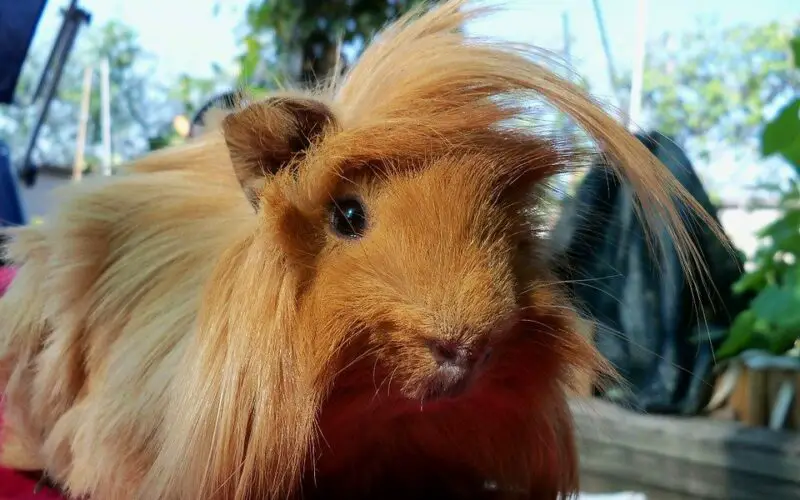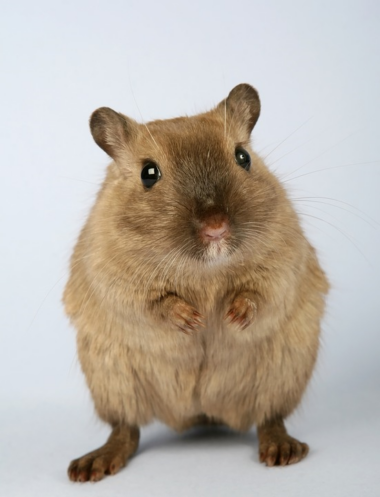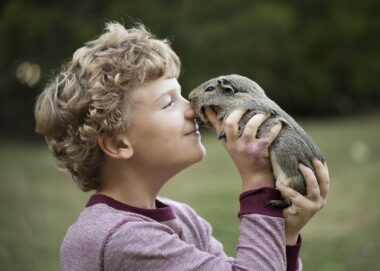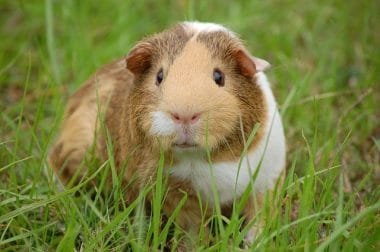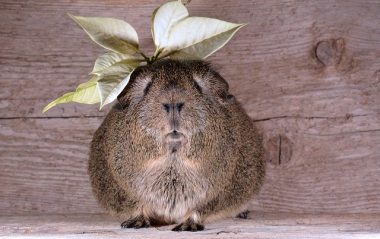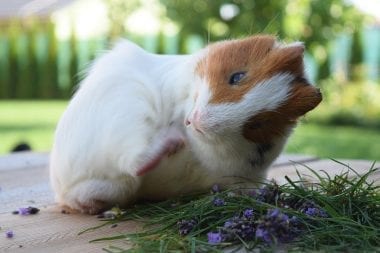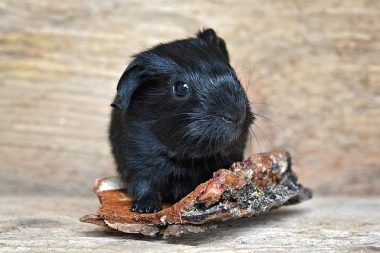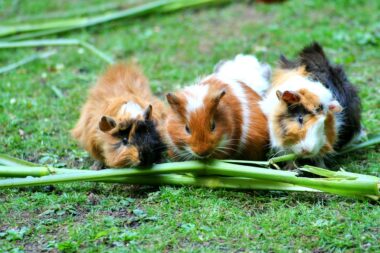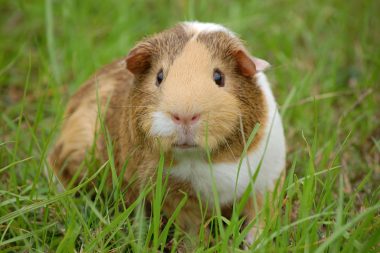The Peruvian guinea pig originates from South America. Contrary to its name, the guinea pig is not a pig and nor does it originate from Guinea. The Peruvian guinea pig belongs to the Caviidae family which are large rodents.
Sometimes called cavies, they are round bodied, short tailed, small limbs, with clawed hairless feet, expressive eyes, and tiny ears.
Also called cavies, they were domesticated during the pre-Columbian period, nearly five hundred years before the arrival of Spanish explorers.
Peruvian guinea pig appearance
Cavies are large pet rodents. Adult males may weigh between two and three pounds whereas female cavies weigh from up to three pounds. In terms of length, cavies measure between six and ten inches. Peruvian cavies are large in the rodent breed and may grow to fourteen inches. Interestingly, their head size is smaller in comparison to the rest of their body.
Coat
The Peruvian guinea pig is much adored for its luscious coat. The length of the top coat may grow up to fourteen inches. In fact, the longest recorded hair length on a Peruvian cavy was twenty inches!
Colors
This breed of guinea pig is available in a wide array of colors. These are:
- Russet red
- Cream
- Tan
- White
- Slate gray
- Chocolate brown
- Black.
The satin color is especially popular. This color is a unique genetic variation. It occurs when there is an extra gene present that leads to a hollow hair shaft. Satin colored Peruvian cavies have soft and shiny fur.
This guinea pig breed is available in a single color, bi color, or tricolor. The presence of three colors is rare and considered desirable for showing. Peruvian cavies are often confused for Cornet or Silkie guinea pigs who also have long fur coats. The differentiating factor is how the hair appears on the face. In the Silkie, the hair sweeps away and back from the face. In the Peruvian guinea pig, the hair forms a part along the spine and fringe bangs appear across the face.
Pig temperament
It’s easy to fall in love with a Peruvian guinea pig because these creatures are affectionate and social. They are curious by nature and compared to other cavy breeds, Peruvians are aware and alert of their surroundings. They are responsive to being handled and fed by humans. Keep in mind that your new cavy will need to develop trust with you before you start holding or handling it. They need time to become familiar with your touch and smell.
Pet parents often wonder whether Peruvian cavies bite. They do not except under certain conditions. When a Peruvian guinea pig feels scared or threatened, it may bite. Another occasion where you might get a nip is if you try to separate two quarreling guinea pigs. However, these biting incidents are rare.
Generally, Peruvian guineas are very affable. It is not challenging to tame them, nevertheless you should exercise caution when doing so. Avoid holding your cavy too tightly. Always supervise your pet when children are handling them and when other pets are around.
Peruvian guinea pig health
This breed has a difficult time grooming itself, mainly because of their long and luscious coats. In addition, their long hair may cause problems when they’re nursing their babies. In fact, the cavy’s babies may have a hard time finding where to get their feed.
Due to the difficulty posed by having a long fur coat, Peruvian cavies are at high risk for developing fly strike. This is a fatal and very painful condition. Fly strike happens when flies lay eggs on your cavy’s fur. Once the maggots hatch, they will start feeding on your pet cavy. This is a highly stressful condition that often leads to death. As a result, it is imperative that pet owners trim and groom their Peruvian cavy’s coat on a regular basis.
Apart from preventing fly strike, pet parents must pay attention to their cavy’s feet. It is prone to infections and sores. This often occurs in enclosures with wire or mesh flooring. If left unchecked, your pet may develop a painful condition called bumble foot. Keeping the cage clean is the only way to prevent this condition.
Dental care
Make it a habit to check your Peruvian guinea pig’s front teeth on a daily basis. This breed has open root teeth. All it means is these teeth are constantly growing. If the teeth grow too much it may lead to illness and infection. It should be filed down or trimmed regularly. Only a certified veterinarian can perform this procedure. Avoid trying to do it yourself.
Lifespan
Your pet Peruvian guinea pig may live between three and eight years. This is a lot longer than most rodent pet breeds such as gerbils and hamsters. Perhaps this is why pet parents like to adopt guinea pigs as first pets.
There are several measures pet parents can take to ensure their cavy leads a happy and healthy life. Access to fresh water and a balanced diet are key to a long life. This is especially necessary if your cavy primarily eats pellet foods.
A clean and large cage is another requirement. If you’re raising two Peruvian cavies, ensure there is at least ten square feet of space in the cage. Adequate space prevents fights for domination and offers lots of room to run and play.
Last but not least, your cavy loves to play. Ensure there are lots of toys, places to hide and climb in the enclosure. Don’t forget to include hideaways where your cavy can curl up and sleep when it feels unsocial.
Smell
Will your Peruvian guinea pig smell? Yes, there is somebody odor present. This variety is not extraordinarily smelly but it depends on how sensitive your nose is. Most of the smell associated with guinea pigs arises from their urine. To minimize the stench, you can take certain measures to minimize it such as scented bedding and regular cage cleaning.
If you notice any peculiar smell that is out of the ordinary, it may indicate an underlying health issue. Speak to the veterinarian immediately.
Care
To ensure your Peruvian cavy leads a healthy life, keep monitoring it for illness and injury. Address signs of discomfort such as:
- Dandruff
- Crusty or swollen eyes
- Sneezing
- Wheezing
In case you notice any of these signs in one guinea pig, separate it from its cage mate. It might be contagious and separating them will keep the illness from spreading. Speak to the veterinarian immediately.
Your Peruvian guinea pig should always have access to the following to lead a happy life:
- Special toys
- Clean cage
- Fresh water
- Fresh and nutritious food
- Chewing blocks.
Peruvian guinea pig food
Your cavy must have a nutritious diet to remain healthy. Peruvian cavies in particular fare well on specially formulated pellets and hay, along with fresh vegetables and fruits.
Fresh fruits and veggies is vital for your cavy. For instance, they are unable to make their own vitamin C. As a result, you need to supplement their diet with vitamin C rich foods to prevent scurvy. Examples of vitamin C rich foods are:
- Oranges
- Apples
- Lemons
- Guavas
- Cabbage.
In addition, cavies are herbivores. They do not possess the stomach enzymes to eat processed foods or meats. It can make them quite sick. Always feed them plant and plant-based foods.
Toxic plants
As pet parents, you must be aware of plants that can be toxic for your cavy. Not all houseplants are safe for them. The following plants are toxic for all guinea pigs:
- Beans
- Rhubarb
- Potato
- Tomato
- dill
Do not let them access garden weeds or cut flowers. It is always better to stay on the safe side. Since Peruvian cavies are inquisitive, they will do some exploratory nibbling. In case your cavy eats something toxic, visit the vet immediately.
Grooming
Although guinea pigs are naturally prone to self-grooming, the Peruvian guinea pig has a hard time grooming itself. Its long fur makes this task close to impossible. As a result, Peruvian cavies are more high maintenance compared to other cavy breeds. They are usually not recommended for small children.
You must brush your cavy twice a day. This prevents tangling and minimizes dirt and debris from accumulating under their coat. Tangled hair causes matting which can become uncomfortable for your cavy. This encourages flies to lay their eggs. In addition, matted hair can lead to sores and skin infections. Your Peruvian cavy depends on you to keep it clean. Keep checking its fur regularly to ensure it’s healthy.
Happiness in pairs
All guinea pigs are social creatures and your Peruvian cavy is no different. It is beneficial for their mental and physical health to keep two cavies of the same gender together.
To prevent fighting and dominance issues, ensure there is enough space for both in the enclosure.
Are you ready to adopt a Peruvian guinea pig?
This breed is affectionate, interactive, and curious. Their beautiful coloring and fur coat gives them a unique and attractive appearance. Like other guinea pigs, Peruvian cavies need regular attention to their grooming, diet, and physical surroundings to lead a long and healthy life.
